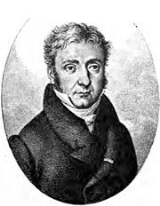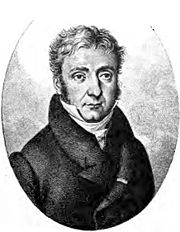
Pierre Louis Dulong
Encyclopedia
Pierre Louis Dulong was a French
physicist
and chemist
, remembered today largely for the law of Dulong and Petit. He worked on the specific heat capacity and the expansion and refractive indices
of gases.
 Dulong was born in Rouen
Dulong was born in Rouen
, France
.
An only child, he was orphaned at the age of 4, he was brought up by his aunt on Auxerre
. He gained his secondary education in Auxerre and the Lycée Pierre Corneille
in Rouen before entering the École Polytechnique
, Paris
in 1801. He began studying medicine, but gave this up to concentrate on science, working under the direction of Thénard
. Dulong succeeded Alexis Thérèse Petit
as professor of physics, from 1820 to 1829, then was directeur des études until his death.
In chemistry, he contributed to knowledge on:
Dulong also discovered the dangerously sensitive nitrogen trichloride
in 1812, losing two fingers and an eye in the process.
In 1819 Dulong collaborated with Petit to show that the mass heat capacity of metal
lic elements
are inversely proportional to their atomic mass
es, this being now known as the Dulong-Petit law. Dulong also worked on the elasticity of steam, on the measurement of temperatures, and on the behavior of elastic fluids. He made the first precise comparison of the mercury- and air-temperature scales. At the time of his death, he was working on the development of precise methods in calorimetry
.
In 1830, he was elected a foreign member of the Royal Swedish Academy of Sciences
. He died in Paris and his is one of the names of 72 scientists inscribed on the Eiffel Tower
.
France
The French Republic , The French Republic , The French Republic , (commonly known as France , is a unitary semi-presidential republic in Western Europe with several overseas territories and islands located on other continents and in the Indian, Pacific, and Atlantic oceans. Metropolitan France...
physicist
Physicist
A physicist is a scientist who studies or practices physics. Physicists study a wide range of physical phenomena in many branches of physics spanning all length scales: from sub-atomic particles of which all ordinary matter is made to the behavior of the material Universe as a whole...
and chemist
Chemist
A chemist is a scientist trained in the study of chemistry. Chemists study the composition of matter and its properties such as density and acidity. Chemists carefully describe the properties they study in terms of quantities, with detail on the level of molecules and their component atoms...
, remembered today largely for the law of Dulong and Petit. He worked on the specific heat capacity and the expansion and refractive indices
Refractive index
In optics the refractive index or index of refraction of a substance or medium is a measure of the speed of light in that medium. It is expressed as a ratio of the speed of light in vacuum relative to that in the considered medium....
of gases.
Life and work

Rouen
Rouen , in northern France on the River Seine, is the capital of the Haute-Normandie region and the historic capital city of Normandy. Once one of the largest and most prosperous cities of medieval Europe , it was the seat of the Exchequer of Normandy in the Middle Ages...
, France
France
The French Republic , The French Republic , The French Republic , (commonly known as France , is a unitary semi-presidential republic in Western Europe with several overseas territories and islands located on other continents and in the Indian, Pacific, and Atlantic oceans. Metropolitan France...
.
An only child, he was orphaned at the age of 4, he was brought up by his aunt on Auxerre
Auxerre
Auxerre is a commune in the Bourgogne region in north-central France, between Paris and Dijon. It is the capital of the Yonne department.Auxerre's population today is about 45,000...
. He gained his secondary education in Auxerre and the Lycée Pierre Corneille
Lycée Pierre Corneille (Rouen)
The Lycée Pierre-Corneille is a school in Rouen, France. It was founded by the Archbishop of Rouen, Charles, Cardinal de Bourbon and run by the Jesuits to educate the children of the aristocracy and bourgeoisie in accordance with the purest doctrinal principles of Roman Catholicism...
in Rouen before entering the École Polytechnique
École Polytechnique
The École Polytechnique is a state-run institution of higher education and research in Palaiseau, Essonne, France, near Paris. Polytechnique is renowned for its four year undergraduate/graduate Master's program...
, Paris
Paris
Paris is the capital and largest city in France, situated on the river Seine, in northern France, at the heart of the Île-de-France region...
in 1801. He began studying medicine, but gave this up to concentrate on science, working under the direction of Thénard
Louis Jacques Thénard
Louis Jacques Thénard , was a French chemist.His father, a poor peasant, managed to have him educated at the academy of Sens, and sent him at the age of sixteen to study pharmacy in Paris. There he attended the lectures of Antoine François Fourcroy and Louis Nicolas Vauquelin...
. Dulong succeeded Alexis Thérèse Petit
Alexis Thérèse Petit
Alexis Thérèse Petit was a French physicist. Petit is known for his work on the efficiencies of air- and steam-engines, published in 1818...
as professor of physics, from 1820 to 1829, then was directeur des études until his death.
In chemistry, he contributed to knowledge on:
- the double decomposition of salts (1811)
- nitrous acidNitrous acidNitrous acid is a weak and monobasic acid known only in solution and in the form of nitrite salts.Nitrous acid is used to make diazides from amines; this occurs by nucleophilic attack of the amine onto the nitrite, reprotonation by the surrounding solvent, and double-elimination of water...
(1815) - the oxideOxideAn oxide is a chemical compound that contains at least one oxygen atom in its chemical formula. Metal oxides typically contain an anion of oxygen in the oxidation state of −2....
s of phosphorusPhosphorusPhosphorus is the chemical element that has the symbol P and atomic number 15. A multivalent nonmetal of the nitrogen group, phosphorus as a mineral is almost always present in its maximally oxidized state, as inorganic phosphate rocks...
(1816) - the oxides of nitrogenNitrogenNitrogen is a chemical element that has the symbol N, atomic number of 7 and atomic mass 14.00674 u. Elemental nitrogen is a colorless, odorless, tasteless, and mostly inert diatomic gas at standard conditions, constituting 78.08% by volume of Earth's atmosphere...
- catalysisCatalysisCatalysis is the change in rate of a chemical reaction due to the participation of a substance called a catalyst. Unlike other reagents that participate in the chemical reaction, a catalyst is not consumed by the reaction itself. A catalyst may participate in multiple chemical transformations....
by metals (1823, with Thénard)
Dulong also discovered the dangerously sensitive nitrogen trichloride
Nitrogen trichloride
Nitrogen trichloride, also known as trichloramine, is the chemical compound with the formula NCl3. This yellow, oily, pungent-smelling liquid is most commonly encountered as a byproduct of chemical reactions between ammonia-derivatives and chlorine .In pure form, NCl3 is highly reactive...
in 1812, losing two fingers and an eye in the process.
In 1819 Dulong collaborated with Petit to show that the mass heat capacity of metal
Metal
A metal , is an element, compound, or alloy that is a good conductor of both electricity and heat. Metals are usually malleable and shiny, that is they reflect most of incident light...
lic elements
Chemical element
A chemical element is a pure chemical substance consisting of one type of atom distinguished by its atomic number, which is the number of protons in its nucleus. Familiar examples of elements include carbon, oxygen, aluminum, iron, copper, gold, mercury, and lead.As of November 2011, 118 elements...
are inversely proportional to their atomic mass
Atomic mass
The atomic mass is the mass of a specific isotope, most often expressed in unified atomic mass units. The atomic mass is the total mass of protons, neutrons and electrons in a single atom....
es, this being now known as the Dulong-Petit law. Dulong also worked on the elasticity of steam, on the measurement of temperatures, and on the behavior of elastic fluids. He made the first precise comparison of the mercury- and air-temperature scales. At the time of his death, he was working on the development of precise methods in calorimetry
Calorimetry
Calorimetry is the science of measuring the heat of chemical reactions or physical changes. Calorimetry is performed with a calorimeter. The word calorimetry is derived from the Latin word calor, meaning heat...
.
In 1830, he was elected a foreign member of the Royal Swedish Academy of Sciences
Royal Swedish Academy of Sciences
The Royal Swedish Academy of Sciences or Kungliga Vetenskapsakademien is one of the Royal Academies of Sweden. The Academy is an independent, non-governmental scientific organization which acts to promote the sciences, primarily the natural sciences and mathematics.The Academy was founded on 2...
. He died in Paris and his is one of the names of 72 scientists inscribed on the Eiffel Tower
Eiffel Tower
The Eiffel Tower is a puddle iron lattice tower located on the Champ de Mars in Paris. Built in 1889, it has become both a global icon of France and one of the most recognizable structures in the world...
.

